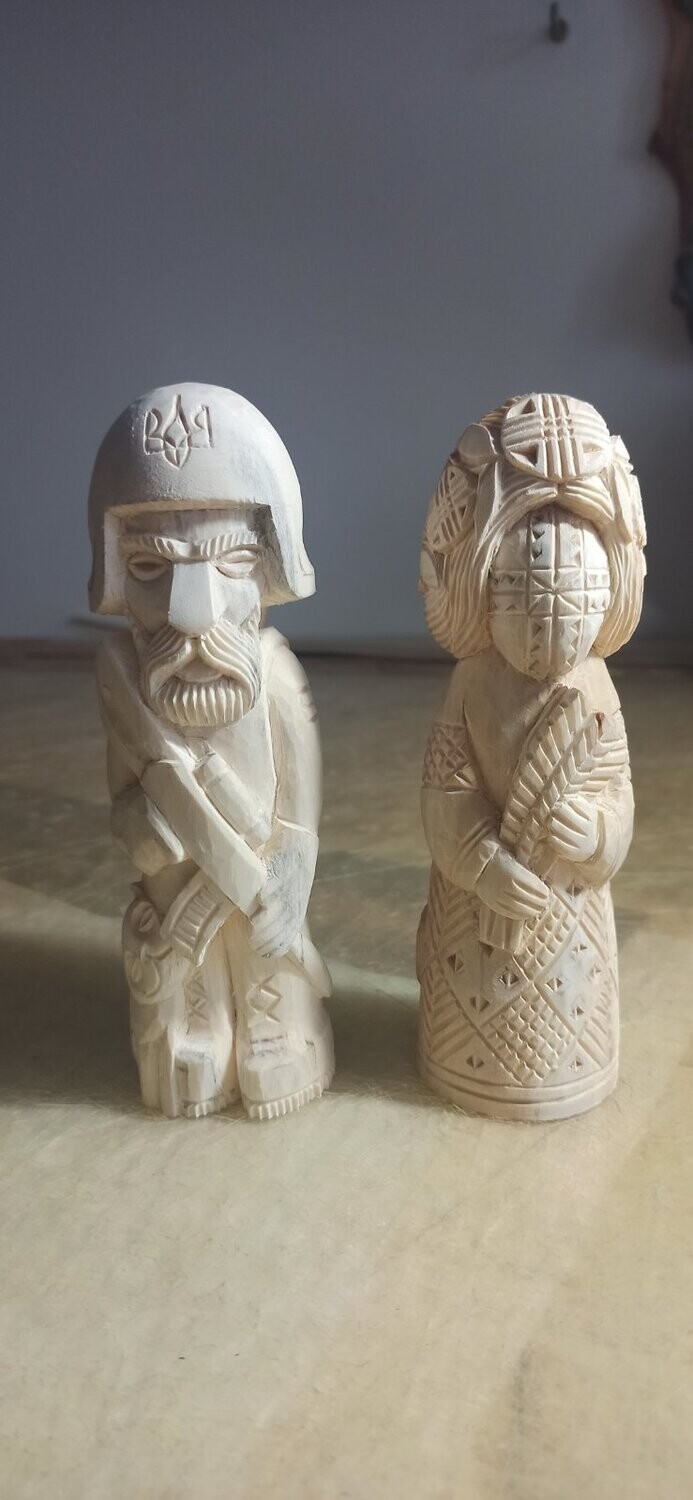ZSU Soldier + Motanka Doll (handmade in Ukraine)
Ukrainian Motanka Doll (Wood) + ZSU Warrior, 2022
Patriotic wood carving (handmade in Ukraine)
Unique wood figurine, H. 18 cm
Carved from Basswood by famous Ukrainian artisan Sergiy Haruk.
The history of Motanka, a traditional Ukrainian guardian doll.
Motankas (Мотанка) are ancient Ukrainian family talismans. They are the symbol of prosperity, goodness and hope. Then first knotted dolls appeared about 5,000 years ago, and represented the unity of the family and deep connection between multiple generations.
The name "motanka" comes from the word “motaty” (to wind) ie to make a knotted doll out of fabric, without using a needle and scissors. Motanka served as a talisman of human destiny and our ancestors believed that destiny cannot be pierced or cut. Generally dolls were in the shape of a human figure, usually a woman or a child, and were made from pieces of fabric from old clothes of family members connected by knots.
Each doll was unique and made with only good intentions and sincerity as it was believed that it has power and will act as a protector of a household and it’s inhabitants.
Motankas differ from ordinary dolls by "empty" faces. Our ancestors believed that giving the doll a face could tie a person's soul to it. Therefore faces have no facial features and instead the Motanka dolls have multicoloured threads laid out in a cross shape across the face instead. The cross is a pagan symbol of the Sun where horizontal lines meant feminine, and vertical - masculine.
Motanka dolls can be divided into three categories: ceremonial (obryadova), guardian (berehynya) and children’s play dolls.
The ceremonial doll was made for certain holidays and so was named accordingly: Kolyada, Vesilna, Vesnyanka, Paschalna, Kupavka, etc.
Guardian motankas were created with a specific purpose in mind, such as successful pregnancy and health, well-being and wealth, harmony, success and happiness. In the middle of such dolls it was common to place healing herbs and coins.
Play dolls for children helped to develop fine motor skills, as well as future caretaking skills in girls.
Because dolls had specific purposes they were named accordingly. For example:
- Ochysna (cleansing) doll was to get rid of bad energy in the house;
- Ten-handed (Desyatyruchka) doll always helped the hostess in household chores;
- To get married successfully, a Cabbage (Kapustka) doll was displayed in the window;
- Princess (Knyahynya) was the most popular female talisman that helped with family affairs;
- Inseparable dolls (Nerozluchnyki) were often gifted at the wedding so that they would preserve unity and fidelity of the couple;
- The most beautiful doll was the Bride (Narechena) as she looked like a young girl with a long braid - a symbol of a long married life;
- Fertility (Rodyuchistʹ) Motanka was gifted with a wish of many children to be born to the family;
- Traveler doll (Podorozhnytsya) guaranteed the owner a happy return home, and helped to stay warm and full while travelling;
- To protect the baby from illnesses, the mother would put a Swaddle (Pelenashka) doll into the crib. Sometimes breadcrumbs were wrapped into these dolls and they also acted as pacifiers. For additional protection from diseases, 12 small motankas were made from healing herbs and given to the child to play with. Each doll absorbed the disease and after they performed this protective function they were burned;
- Guardian Motanka or Berehynya was associated with the Mother - a symbol of care, love and prosperity. Therefore, she was always depicted with her head covered, large breasts and a cross on her face.
Colors also played an important role in the making of the motanka doll:
- red - symbolized protection against diseases and evil spirits;
- yellow - the personification of the life-giving power of the Sun;
- green - a symbol of rebirth, health, youth and Mother Nature;
- blue and navy - the continuous movement of the healing water;
- brown was associated with Mother Earth and fertility;
- white - divine heaven, purity and harmony.
Lastly, much meaning was given to when and how Motanka was created. The process of making such dolls is called “kutannya” or swaddling as it is very similar to swaddling a baby. Motankas were made by women using the lunar calendar. On the full moon the doll was created for protection; on the descending moon- to protect from diseases and failures; Motankas made during the ascending moon were for achieving a good result in any business.
Additionally, it was forbidden to make dolls on Friday and Sunday, because these days belong to the goddess of women's diligence and needlework, Makosha. A doll had to be made in one day using natural fabrics and threads. The winding of the doll was to be carried out only clockwise, always accompanied by positive thoughts.
During the Soviet times, traditions associated with making Motanka dolls were somewhat lost. However, more recently these dolls have made a come back and many households in Ukraine and overseas have acquired Motanka dolls as traditional Ukrainian oberihs.
We have been very fortunate to partner up with a local artist (originally from Ukraine now living in Saskatoon, Canada), Natalia Garmasar, who makes wonderful Motanka dolls for us. She follows traditional ways of making these dolls and each is done with love and care. 
As each Motanka doll is unique, no two dolls are alike. Pictures on our site are for reference, and some variations in clothing/accessories is possible. Ref: www.Ukieology.com
#motanka #motankadoll #ukrainian #shoplocal
Rag doll
From Wikipedia, the free encyclopedia
This article is about the rag doll that is a children's toy.
A rag doll is a children's toy. It is a cloth figure, a doll traditionally home-made from (and stuffed with) spare scraps of material. They are one of the oldest children's toys in existence. Today, many rag dolls are commercially produced to simulate the features of the original home-made dolls, such as simple features, soft cloth bodies, and patchwork clothing.
History
Traditionally home-made from (and stuffed with) spare scraps of material, they are one of the oldest children's toys in existence. The British Museum has a Roman rag doll, found in a child's grave dating from the 1st to 5th century AD.[1] Historically, rag dolls have been used as comfort objects, and to teach young children nurturing skills. They were often used to teach children how to sew, as the children could practice sewing clothes for the doll and make some simple dolls themselves.[2] In America, from the colonial era up to the early 20th century, children of various statuses would play with dolls made from rags or cornhusks.[3] Mass production of rag dolls began around 1830, when fabric color printing was first developed.[4]
Amish

Amish dolls are a type of traditional American rag dolls which originated as children's toys among the Old Order Amish people. These dolls commonly have no facial features.
Slavic
Motanka dolls (Polish motanka, Ukrainian мо́танка, from motać / мотати - to tangle/spool) are a type of traditional amulet dolls made in Poland and Ukraine mainly.They were a part of folk culture (Vasilisa the Beautiful) and its magical beliefs, made and tied without the use of a needle or other sharp objects, to "not poke/hurt the fate" and traditionally had no facial features, sometimes with a cross instead. Motanka dolls were made with specific intentions and wishes/tasks for them to grant, of various sorts, such as guarding the family or a prosperous marriage. Nowadays motanka dolls are coming back to popularity as a part of interest in Slavic cultures of the past, often as an educational device during educational and ethnographic workshops, or as a work of folk artists.
Traditional materials
In their earlier forms, rag dolls were made out of cloth scraps or cornhusks.[2] In the 19th and 20th century, rag dolls were made out of stockinette, felt, or velvet.[4]
In popular culture
Rag dolls have featured in a number of children's stories, like the 19th century character Golliwogg, Raggedy Ann in the 1918 book by Johnny Gruelle and the British children's television series Bagpuss and Ragdolly Anna, and Emilia from the Brazilian fantasy novel series Sítio do Picapau Amarelo by Monteiro Lobato. The character of Sally from The Nightmare Before Christmas is also a rag doll. In the Lilo & Stitch franchise, Lilo Pelekai owns a rag doll that she made herself named Scrump, who she holds onto as a comfort object.



